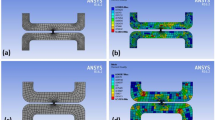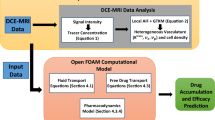Abstract
Purpose. To develop a two-dimensional simulation platform for the transport of doxorubicin to the hepatoma. To examine the temporal and spatial variation of doxorubicin concentration and its penetration into the tumor and the surrounding normal tissues.
Methods. Simulations are carried out with Fluent/UNS using the finite volume method to obtain the interstitial fluid pressure, velocity, and concentration profiles.
Results. Interstitial fluid pressure in the tumor and core reaches a steady state value in about 800 s, corresponding well with the assumed time scale for interstitial matrix fluid percolation (∼1000 s). There is a strong correlation between the drug concentration in the interstitial space of tumor and blood plasma for time >> 1 h. Concentration of doxorubicin is highest in the viable zone of the tumor at early times and in the necrotic core at later times, and lowest in the surrounding normal tissues. Diffusion is the dominant form of transport for doxorubicin.
Conclusions. Varying the volume of solution injected, while keeping the dosage the same, does not cause significant changes in the amount and distribution of drug in the tumor. A higher vascular exchange area leads to higher concentrations of drug in the tumor. Lymphatic drainage in the tumor causes negligible reductions in the mean concentrations in all three different zones. Cellular metabolism and DNA binding kinetics decrease the mean concentrations of drug by about 15 to 40%, as compared to the baseline case.
Similar content being viewed by others
REFERENCES
R. Yamada, K. Kishi, M. Terada, T. Sonomura, and M. Sato. Transcatheter arterial chemoembolization for unresectable hepatocellular carcinoma. In T. Tobe (ed.), Primary Liver Cancer in Japan, Springer-Verlag, Tokyo and New York, 1992 pp. 259-271.
L. B. Grochow and M. Matthew. A Clinician's Guide to Chemotherapy Pharmacokinetics and Pharmacodynamics, Williams & Wilkins, Baltimore, 1998.
P. A. Netti, L. T. Baxter, Y. Boucher, R. Skalak, and R. K. Jain. Time-dependent behaviour of interstitial fluid pressure in solid tumors: Implications for drug delivery. Cancer Res. 55:5451-5458 (1995).
P. A. Netti, L. M. Hamberg, J. W. Babich, D. Kierstead, W. Graham, G. J. Hunter, G. L. Wolf, A. Fischman, Y. Boucher, and R. K. Jain. Enhancement of fluid filtration across tumor vessels: Implications for delivery of macromolecules. Proc. Natl. Acad. Sci. USA 96:3137-3142 (1999).
L. T. Baxter and R. K. Jain. Transport of fluid and macromolecules in tumors. I role of interstitial pressure and convection. Microvas. Res. 37:77-104 (1989).
L. T. Baxter and R. K. Jain. Transport of fluid and macromolecules in tumors. II role of heterogeneous perfusion and lymphatics. Microvas. Res. 40:246-263 (1990).
L. T. Baxter and R. K. Jain. Transport of fluid and macromolecules in tumors. III role of binding and metabolism. Microvas. Res. 41:5-23 (1991).
L. T. Baxter and R. K. Jain. Transport of fluid and macromolecules in tumors. IV a microscopic model of the perivascular distribution. Microvas. Res. 41:252-272 (1991).
F. E. Curry. Mechanics and thermodynamics of transcapillary exchange. In S. R. Geiger, E. M. Renkin, and C. C. Michel (eds.), Handbook of Physiology Section 2—The Cardiovascular System IV, Part 1, American Physiological Society, Bethesda, Maryland, 1984 pp. 309-374.
Fluent/UNS & Rampant Version 4.2 User's Guide Volumes 1–4, Fluent, Inc. 1997.
B. W. Zweifach and H. H. Lipowsky. Pressure-flow relations in blood and lymph microcirculation. In S. R. Geiger, E. M. Renkin, and C. C. Michel (eds.), Handbook of Physiology Section 2—The Cardiovascular System IV, Part 1, American Physiological Society, Bethesda, Maryland, 1984 pp. 251-308.
R. K. Jain and J. Wei. Dynamics of drug transport in solid tumors: Distributed parameter model. J. Bioeng. 1:313-330 (1977).
C. H. Wang, J. Li, C. S. Teo, and T. Lee. The delivery of BCNU to brain tumors. J. Controll. Release 61:21-41 (1999).
H. Loveless, E. Arena, R. L. Felsted, and N. R. Bachur. Comparative mammalian metabolism of adriamycin and daunorubicin. Cancer Res. 38:593-598 (1978).
S. Kalyanasundaram, V. D. Calhoun, and K. W. Leong. A finite element model for predicting the distribution of drugs delivered intracranially to the brain. Am. J. Physiol. 273:R1810-R1821 (1997).
Y. M. F. Goh. Simulation of drug delivery to hepatoma, B. Eng. Thesis, Department of Chemical and Environmental Engineering, National University of Singapore (1999).
J. R. Welly, C. E. Wicks, and R. E. Wilson. Fundamentals of Momentum, Heat and Mass Transfer, John Wiley and Sons, New York, 1984.
V. Rizzo, N. Sacchi, and M. Menozzi. Kinetic studies of anthracycline-DNA interaction by fluorescence stopped flow confirm a complex association mechanism. Biochemistry 28:274-282 (1989).
M. Yang, H. L. Chan, W. Lam, and W. F. Fong. Cytotoxicity and DNA binding characteristics of dextran-conjugated doxorubicins. Biochim. Biophys. Acta 1380:329-335 (1998).
F. Gabor, I. Haberl, M. Wirth, K. Richter, G. Theyer, G. Baumgartner, E. Wenzl, and G. Hamilton. In vitro antitumor activity of MIC2 protein-doxorubicin conjugates. Int. J. Oncology 9:527-531 (1996).
R. Kirshna, M. St-Louis, and L. D. Mayer. Increased intracellular drug accumulation and complete chemosensitization achieved in multidrug-resistant solid tumors by co-administering valspodar (PSC 833) with sterically stabilized liposomal doxorubicin. Int. J. Cancer 85:131-141 (2000).
M. Wartenberg, C. Frey, H. Diedershagen, J. Ritgen, J. Hescheler, and H. Sauer. Development of an intrinsic P-glycoprotein-mediated doxorubicin resistance in quiescent cell layers of large, multicellular prostate tumor spheroids. Int. J. Cancer 75:855-863 (1998).
E. M. Renkin. Control of Microcirculation and Blood-tissue Exchange. In S. R. Geiger, E. M. Renkin, and C. C. Michel (eds.), Handbook of Physiology Section 2—The Cardiovascular System IV, Part 2, American Physiological Society, Bethesda, Maryland, 1984 pp. 627-688.
R. K. Jain. Determinants of tumor blood flow: A review. Cancer Res. 48:2641-2658 (1988).
E. M. Winter. Basic Clinical Pharmacokinetics, Applied Therapeutics, Inc., San Francisco, 1980.
J. Robert, N. B. Bui, and P. Vrignaud. Pharmacokinetics of doxorubicin in sarcoma patients. Euro. J. Clin. Pharmacol. 31:695-699 (1987).
D. E. Hilmas and E. L. Gillette. Morphometric analyses of the microvasculature of tumor during growth and after x-irradiation. Cancer 33:103-110 (1974).
Author information
Authors and Affiliations
Rights and permissions
About this article
Cite this article
Goh, YM.F., Kong, H.L. & Wang, CH. Simulation of the Delivery of Doxorubicin to Hepatoma. Pharm Res 18, 761–770 (2001). https://doi.org/10.1023/A:1011076110317
Issue Date:
DOI: https://doi.org/10.1023/A:1011076110317




